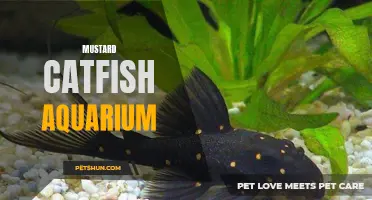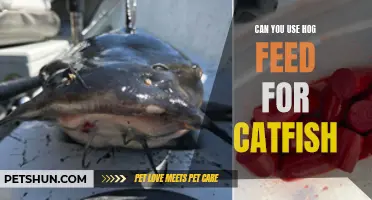
If you are a fish enthusiast or looking to add a unique yet stunning aquatic creature to your home aquarium, then look no further than catfish. These fascinating creatures come in various species, each with its distinct traits and characteristics that make them a captivating addition to any tank. From the graceful Corydoras to the intimidating Plecostomus, catfish have gained popularity for their beauty, adaptability, and ease of care. In this article, we will explore the top 10 catfish for your aquarium, highlighting their unique attributes and why they deserve a spot in your underwater paradise. Get ready to dive into the world of catfish and discover your perfect underwater companion.
| Characteristics | Values |
|---|---|
| Scientific Name | Clarias gariepinus |
| Common Name | African catfish |
| Size | 4-6 feet |
| Lifespan | 8-10 years |
| Temperament | Aggressive |
| Tank Size | 200 gallons or larger |
| Water Temperature | 72-82°F |
| Water pH | 6.5-7.5 |
| Diet | Carnivorous |
| Compatibility | Best kept alone or with large, aggressive fish |
What You'll Learn
- What are the top 10 catfish species recommended for aquariums?
- What size tank is required for the top 10 catfish species?
- What are the ideal water parameters for the top 10 catfish species?
- What type of food do the top 10 catfish species primarily consume?
- Are the top 10 catfish species suitable for community tanks or do they prefer to be kept alone?

What are the top 10 catfish species recommended for aquariums?
Catfish are a popular choice for aquarium enthusiasts due to their unique appearance and interesting behavior. There are many different species of catfish to choose from, but some are better suited for aquariums than others. In this article, we will explore the top 10 catfish species recommended for aquariums based on their compatibility, care requirements, and overall popularity.
- Corydoras Catfish: Corydoras catfish are small, peaceful, and easy to care for. They are bottom-dwellers and can be found in various colorful patterns. They are best kept in schools of at least six individuals and require a sandy substrate.
- Bristlenose Pleco: Bristlenose plecos are known for their unique appearance, with males having bristle-like appendages on their face. They are excellent algae eaters and can help keep your tank clean. They prefer a well-planted tank with hiding spots.
- Otocinclus Catfish: Otocinclus catfish are tiny catfish that are ideal for small aquariums. They are algae eaters and can help prevent the growth of unwanted algae. They are best kept in groups and require a well-established tank.
- Synodontis Catfish: Synodontis catfish come in various species, but the most popular ones are the upside-down catfish and the featherfin catfish. They are mostly peaceful but can grow quite large, so a spacious tank is necessary.
- Banjo Catfish: Banjo catfish are unique in appearance, with a flat body and elongated fins. They are peaceful and can be kept in community tanks. They prefer a well-planted tank with hiding spots and soft substrate.
- Peppermint Catfish: Peppermint catfish, also known as candy cane catfish, are small catfish with a striking peppermint-like pattern on their body. They are peaceful and prefer a well-planted tank with plenty of hiding spots.
- Panda Corydoras: Panda corydoras are a popular choice among catfish enthusiasts due to their adorable black and white pattern. They are social and should be kept in groups of at least six individuals. They prefer a sandy substrate and plenty of hiding spots.
- Glass Catfish: Glass catfish are transparent catfish with a unique see-through appearance. They are peaceful and can be kept in community tanks with other peaceful species. They require a heavily planted tank with open swimming spaces.
- Striped Raphael Catfish: Striped Raphael catfish are nocturnal and have a striking black and white striped pattern. They are best kept in pairs or small groups in a spacious tank with plenty of hiding spots.
- Kuhli Loach: While not technically a catfish, Kuhli loaches are often included in catfish tanks due to their similar behavior and appearance. They are peaceful and prefer a well-planted tank with plenty of hiding spots.
When selecting catfish species for your aquarium, it is essential to consider their compatibility with other species in your tank and their specific care requirements. It is also crucial to provide a well-balanced diet and maintain proper water parameters to ensure the health and well-being of your catfish. With proper care and attention, these top 10 catfish species can thrive in your aquarium and provide you with hours of enjoyment observing their unique behaviors and interactions.
The Adorable World of Baby Catfish: Caring for Them in your Aquarium
You may want to see also

What size tank is required for the top 10 catfish species?
When it comes to keeping catfish as pets, the size of the tank is a crucial factor to consider. Different catfish species have different requirements in terms of tank size, and it is important to provide them with enough space to thrive and grow. Let's take a look at the top 10 catfish species and the tank sizes required for each of them.
- Corydoras Catfish: These small catfish species are often kept in groups. A tank size of at least 20 gallons would be suitable for a small group of Corydoras catfish.
- Bristlenose Pleco: This popular catfish species requires a tank size of around 30 gallons. They are known to be excellent algae eaters and can grow up to 5-6 inches in length.
- Otocinclus Catfish: These tiny catfish species are great for nano tanks. A tank size of 10 gallons would be sufficient to house a small group of Otocinclus catfish.
- Siamese Algae Eater: These catfish species are highly efficient at removing algae from the tank. A tank size of at least 30 gallons would be suitable for a Siamese Algae Eater.
- Plecostomus: This larger catfish species can grow up to 24 inches in length. It requires a tank size of at least 100 gallons to accommodate its size and ensure optimum water quality.
- Redtail Catfish: The Redtail Catfish is a massive catfish species that can easily reach sizes of up to 4 feet in the wild. For an adult Redtail Catfish, a tank size of 300 gallons or more is recommended.
- Channel Catfish: Channel Catfish can grow to be quite large, reaching sizes of up to 4 feet in length. A minimum tank size of 150 gallons is recommended for an adult Channel Catfish.
- Featherfin Catfish: This catfish species can grow to be around 6-8 inches in length. A tank size of 30 gallons or larger would be suitable for a Featherfin Catfish.
- Glass Catfish: The Glass Catfish is a unique catfish species known for its transparent body. They are schooling fish and should be kept in groups of at least 5. A tank size of 20 gallons or larger would be suitable for a group of Glass Catfish.
- African Squeaker: These catfish species are small and peaceful. A tank size of 10-15 gallons would be suitable for a small group of African Squeaker catfish.
It is important to note that these tank sizes are minimum recommendations and providing larger tanks for your catfish will always be beneficial. A larger tank not only allows for more swimming space but also helps maintain better water quality and reduces stress on the fish.
In conclusion, the tank size required for catfish species varies depending on their size, behavior, and preferred habitat. It is important to research the specific requirements of the catfish species you plan to keep and provide them with an appropriate tank size to ensure their overall well-being and longevity in captivity.
Feeding Baby Catfish in the Aquarium: Essential Tips and Guidelines
You may want to see also

What are the ideal water parameters for the top 10 catfish species?
Catfish are a diverse group of fish known for their barbels or whiskers, which resemble a cat's whiskers. There are over 3,000 species of catfish, but some of the most popular ones kept in aquariums include the Corydoras, Synodontis, and Plecostomus. To keep these catfish healthy and happy, it is crucial to maintain the appropriate water parameters in their tank.
Water temperature is one of the most important factors to consider when setting up an aquarium for catfish. Most catfish species prefer a temperature range between 72°F and 82°F (22°C and 28°C). However, some species, like the Bristlenose Plecostomus, enjoy slightly cooler temperatures around 68°F to 77°F (20°C to 25°C). It is important to research the specific requirements of each species and adjust the water temperature accordingly.
PH levels also play a crucial role in maintaining a healthy environment for catfish. Most catfish species prefer slightly acidic to neutral water conditions, with a pH range between 6.5 and 7.5. However, some catfish species, like the African Featherfin Catfish, require a slightly higher pH level between 7.5 and 8.5. Regular testing of the water's pH level is essential to ensure it remains within the suitable range for the catfish species in the tank.
Water hardness, or the concentration of dissolved minerals in the water, is another important factor to consider. Catfish generally prefer soft to moderately hard water, with a range of 4 to 12 dGH (degrees of General Hardness). It is worth noting that some catfish species, like the Ghost Catfish, thrive in softer water with a hardness of 1 to 6 dGH. Monitoring and maintaining the appropriate water hardness is crucial for the overall health and well-being of catfish.
Most catfish species are native to rivers and streams, so they require well-oxygenated water. Proper filtration and regular water changes are key to maintaining high oxygen levels in the tank. It is recommended to provide additional aeration through the use of air stones or a powerhead. This ensures that the catfish have access to enough oxygen to thrive.
In addition to these general water parameters, different species may have specific requirements. For example, the Clown Plecostomus prefers dimly lit tanks with plenty of hiding places, while the Peppered Corydoras appreciates a sandy substrate to sift through. It is important to research the specific needs of each catfish species to provide optimal care and create a suitable environment.
Maintaining the ideal water parameters for catfish is crucial for their overall health and well-being. Regular testing, appropriate temperature, pH levels, and water hardness, as well as proper filtration and aeration, are key components of creating a suitable environment. By understanding and meeting these requirements, catfish owners can ensure their beloved fish thrive and exhibit their natural behaviors.
Insight into the Winter Feeding Habits of Flathead Catfish
You may want to see also

What type of food do the top 10 catfish species primarily consume?
In the world of catfish, there are numerous species that inhabit different bodies of water across the globe. Each species has its own unique characteristics and dietary preferences. In this article, we will explore the top 10 catfish species and the type of food they primarily consume.
- Channel Catfish (Ictalurus punctatus): Channel catfish are omnivorous and will eat a wide variety of food, including insects, crustaceans, small fish, and plant matter.
- Blue Catfish (Ictalurus furcatus): Blue catfish are opportunistic predators. They primarily feed on other fish species, such as shad, herring, and sunfish.
- Flathead Catfish (Pylodictis olivaris): Flathead catfish are known for their preference for live prey. They primarily feed on small fish, crayfish, and other aquatic invertebrates.
- Wels Catfish (Silurus glanis): The Wels catfish is the largest catfish species in Europe. It is a predatory fish and will consume a wide range of prey, including fish, amphibians, birds, and small mammals.
- Redtail Catfish (Phractocephalus hemioliopterus): Redtail catfish are primarily piscivorous, meaning they primarily feed on fish. They are also known to consume small crustaceans and insects.
- Thorny Catfish (Doras spp.): Thorny catfish are bottom dwellers and primarily feed on detritus, algae, and other organic matter found on the riverbed.
- Piraiba Catfish (Brachyplatystoma filamentosum): Piraiba catfish are large predatory fish found in South American rivers. They primarily feed on other fish species, such as smaller catfish and piranhas.
- Goonch Catfish (Bagarius yarrelli): Goonch catfish are known for their predatory nature. They primarily feed on small fish, crustaceans, and even small mammals that venture close to the water's edge.
- Blue Channel Catfish (Ictalurus furcatus x Ictalurus punctatus): Blue Channel catfish are a hybrid species that exhibit characteristics of both their parent species. They have a similar diet to channel catfish, consuming insects, crustaceans, and small fish.
- Tiger Shovelnose Catfish (Pseudoplatystoma fasciatum): Tiger shovelnose catfish are voracious predators. They primarily feed on smaller fish, crustaceans, and even birds that venture near the water's surface.
While the above information provides a general overview of the primary food sources for these top 10 catfish species, it is important to note that individual catfish may vary in their dietary preferences depending on their size, habitat, and availability of prey. Additionally, environmental factors such as seasonal changes and water conditions can also influence their food choices.
Ultimately, understanding the dietary preferences of different catfish species can be beneficial for anglers and aquarists alike. By incorporating baits or feeding strategies that mimic their natural diet, it increases the chances of success in catching or properly caring for these fascinating fish.
The Benefits and How to Feed Your Green Cory Catfish Frozen Green Peas
You may want to see also

Are the top 10 catfish species suitable for community tanks or do they prefer to be kept alone?
When it comes to deciding whether or not to keep catfish in a community tank, it is important to consider both the specific species of catfish and the other fish that will be housed in the tank. While some catfish species are docile and tolerant of tank mates, others are more solitary and may become aggressive in a community setting. In this article, we will explore the top 10 catfish species and discuss their suitability for community tanks or preference for being kept alone.
- Corydoras Catfish: Corydoras catfish are small, peaceful species that thrive in community tanks. They are social fish and enjoy the company of their own kind. It is recommended to keep them in groups of at least six.
- Bristlenose Pleco: Bristlenose plecos are also peaceful catfish that are suitable for community tanks. They are known for their algae-eating abilities and are often added to tanks to help with tank maintenance.
- Otocinclus Catfish: Otocinclus catfish are peaceful, active catfish that are well-suited for community tanks. They are excellent at consuming algae and can be kept in groups.
- Clown Pleco: Clown plecos are relatively peaceful catfish that can be kept in community tanks. They are known for their unique coloration and are generally compatible with other peaceful fish.
- Pictus Catfish: Pictus catfish are semi-aggressive and can become territorial, especially when they reach adult size. They may not be suitable for community tanks with smaller or more timid fish.
- Red Tail Catfish: Red tail catfish are large predatory catfish that require a spacious tank and should be housed alone or with other large, aggressive fish. They are not recommended for smaller community tanks.
- Featherfin Squeaker: Featherfin squeakers are peaceful catfish that can be kept in community tanks. They are known for their distinctive finnage and are generally compatible with other peaceful fish.
- Synodontis Catfish: Synodontis catfish are generally peaceful and can be kept in community tanks. However, some species may become territorial and aggressive as they grow, so it is important to research the specific species before adding them to a community tank.
- Glass Catfish: Glass catfish are peaceful and can be kept in community tanks. They are known for their translucent bodies and unique appearance.
- Upside-Down Catfish: Upside-down catfish are peaceful catfish that can be kept in community tanks. They are known for their ability to swim upside-down and are generally compatible with other peaceful fish.
In conclusion, the suitability of catfish species for community tanks varies depending on the specific species. While some catfish species are peaceful and can thrive in community settings, others are more solitary and may become aggressive. It is important to research the specific needs and behaviors of each catfish species and consider the compatibility with other tank mates before making a decision.
The Drawbacks of Using Blood Meal in Catfish Feed
You may want to see also
Frequently asked questions
There are many types of catfish that are suitable for aquariums. Some of the top choices are the Corydoras catfish, Bristlenose Plecos, and Otocinclus catfish. These species are known for their small size, peaceful temperament, and ability to adapt well to the aquarium environment.
The number of catfish you should have in your aquarium depends on the size of the tank and the specific species you choose. As a general guideline, it is recommended to have at least 4-6 Corydoras catfish or 1-2 Bristlenose Plecos for a 20-gallon tank. For larger tanks, you can have more catfish, but be sure to provide enough space and hiding spots for each fish.
Catfish are omnivorous and will eat a variety of foods. In a well-balanced diet, you should include high-quality sinking pellets or flakes specifically formulated for catfish. You can also supplement their diet with live or frozen food such as bloodworms, brine shrimp, and daphnia. It's important to vary their diet to ensure they receive all the necessary nutrients.







